Updated on January 5, 2023
The sales process heavily relies on automation, in an effort to take care of important tasks taking too much out of the sales team’s time. Email drip campaigns help sales teams to personalize their emails at scale and drive engagement by delivering targeted and relevant messages at the right time. Setting up a drip campaign can be challenging, which is why we put together this guide, to help you create the best email drip campaigns. Let’s get started.
Email drip campaign tips and best practices
There are a couple of things you need to be aware of so you can create and set up your email sequence. You need to know how to write your emails, when and how many emails you should send as well as several other key points that can contribute greatly to the success of your email drip campaigns.
Personalize your emails
Tailor your email drips based on the information you have available for the recipients. Emails with a personalized subject line have on average a 26% higher open rate. Personalize the subject line and the email copy to improve the effectiveness of your emails. Even though the messages in the sequence are automated you should personalize parts of the message based on individual pieces of information.
Especially important for outbound sales campaigns, the more personalized your message is the better. Custom tags make personalizing the email copy easy with the use of custom tags. The prospect’s name, job title, company and in the case of hyper-personalization, information like company growth or recent business developments can add that little bit of an extra punch to the email.
Keep the email copy short and focused
The email copy of your emails should align with the goal of the drip campaign in mind and to connect with the CTA, clearly focusing on the action you want the recipient to take. Emails that are too long or packed with too much content have the opposite effect. Plan out the email sequence and create your email copies and the accompanying content accordingly.
Use the CTA to achieve your goal
One CTA (call-to-action) in your email is enough, pushing the recipient to take a specific action. Whether it is scheduling a call or signing up for a trial, a CTA is a great way to urge them to take action. Be sure to not ask too much of them too soon though.
The CTA should be tailored according to their buyer’s journey in the case of sales prospecting. Asking them to sign up in your first email sent to them is asking too much too early. Follow their journey through the sales stages and set your CTAs appropriately.
Choose the right time to send the email
Timing is important. Choosing the right time of day to send the emails can be beneficial for your drip emails. Set the schedule of the emails in the sequence based on the recipient’s time zone and work hours.
Some say that sending your emails on Tuesday or Thursday from 10 in the morning to 2 in the afternoon is the sweet spot. My advice is to test different time schedules and see when your open and reply rates are the highest. This will tell you exactly when your recipients open and read your emails.
Follow up before giving up
If you don’t receive a reply, always send a follow-up email instead of calling it a day and finishing the sequence. This is true especially for sales drip campaigns where it takes several follow-ups to connect with prospects playing hard to get. Sending several follow-up emails is perfectly fine to try and get the ball rolling with a prospect, it’s not annoying it’s just you being persistent and not giving up on a potential customer that easily.
Give recipients the choice to unsubscribe
Naturally, you shouldn’t take no for an answer but know when it’s time to stop. If you’ve sent a couple of follow-ups and you’re still not getting a reply then it’s time to send a “break-up” email and remove them from the drip.
You must offer your prospects the choice to unsubscribe. If they’re not interested in what you have to offer the chances are they’re not your target audience. Not to mention privacy regulations as well which clearly state that you shouldn’t send emails to people that don’t want to receive them.
Include an unsubscribe link in your emails so a prospect that wants to be excluded from the sequence can easily do so. This way you avoid your emails being reported as spam and having to deal with a larger problem down the line. You can even use a domain blocker option, in case a founder or a decision-maker thinks you are not their cup of tea.
Don’t use your main domain for sending emails
Protect the email sending reputation of your main domain by using a different domain for your outbound sales. Since sales teams rely heavily on cold email campaigns as a reliable way of generating new customers and revenue that means sending emails to a large number of prospects.
If you also happen to have a larger sales team, the outbound process gets more complex and more difficult to manage. Before you know it your email bounce rate has jumped because of bad emails in the drip and now you have to deal with email deliverability issues. It’s better to get ahead of the issue and use other domains for your outbound sales sequences
You can use your main domain for sending a newsletter and keeping your customers informed with product updates and new content.
Keep your email bounce rate low
On the topic of email bounce rate, always make sure to keep yours low. There are several ways to go about this, the most important one being to always send your emails only to verified email addresses. A quick email verification can help protect your email reputation and maintain your email deliverability high. As a general rule try to keep your email bounce rate under 3%.
Ask for feedback when you need it
Don’t get discouraged if a prospect doesn’t respond or your campaign is not performing as you expected. If you’re having trouble reaching out to your target audience and engaging prospects you can always ask for help.
Talk with the rest of your sales team to see how their drip campaigns are performing and if they’re getting more replies find out the why together. Sit down with your sales manager as well to see why your open and reply rates are low and what you can do to improve them.
Your other option is to ask your prospects themselves for feedback. Send them a quick microsurveys
to better understand why your email drips are underperforming. Perhaps they went with your competitor’s product, they don’t have the budget or maybe it just wasn’t the right time, to get your answers you must ask them directly.
Monitor and optimize your campaigns
Keep an eye on your email metrics and analyze the results of your drip campaigns. In addition to your main goal you should track five key campaign metrics:
-
- Opened the email – find out how many of your email recipients got interested by your subject line and opened your email
- Click rate tracking – if the prospect clicked on a link in your email, meaning they’re curious about what you’re offering
- Replied to the email – this is a key metric as it usually implies that they’re ready to talk business and want to find out more
- Emails that bounced – keep track of the emails that haven’t reached their intended inbox for some reason
- Opted out of the campaign – sometimes people are just not interested in your outreach and that’s ok, since this way you won’t waste your time sending them messages
Based on the insight you get from analyzing the results of your email drip campaigns, you can make adjustments. For example, if your open rate is low, change the subject line, or if your click and reply rates are less than what you’d expect then your email copy and CTA need to be improved. Whichever changes you make to your email, it is best to test them. A/B testing is a great way to see what works and the changes you made result in improved campaign results.
Remember to only test one change at a time so you can know what changes had an effect on your results. For example, test only the subject line to improve your open rate and so on. You can test different parameters through A/B testing, like when the right time to send the email, even the level of email personalization and segmentation work best for your target audience.
Watch your email sending frequency
When you plan out how your email drip campaigns will last, pay special attention to the purpose of every email. Then you’ll need to space them out throughout your campaign’s time schedule. If you are sending too many emails in a short amount of time, you’re doing it wrong. An email sequence should have just the right amount of emails needed, no more no less.
Respect the email sending limit
On a related subject, while speaking of email sending frequency, we should also talk about daily email sending limits. Most email automation tools use your email address to automate the task of sending emails, which means that certain email sending restrictions apply. Email service providers have a limit on the number of emails you can send per day. Naturally, that limit is increased for paid email accounts.
New email accounts may take a while to reach the max daily sending limit however, due to certain restrictions in place to discourage sending lots of emails in a short amount of time email providers can see as spam.
For example, if you have a new sales rep on the team with a new email account it will take a while to warm up their email. This is done by increasing the daily email sending activity. In other words, using their email account to regularly send and receive emails. There are ways to automate the email warm-up, however.
When it comes to sales, it is always better to create smaller, more targeted email campaigns. That way you don’t risk overstepping the daily sending limit, making it easier to maintain your sender reputation.
How to set up and create an email drip campaign
Crafting an email drip campaign is easy. Here are a couple of steps to help you set up an email drip campaign.
1. Choose your drip campaign software
If you’re reading this, then you’ve probably decided on which drip campaign tool you’re going to use and welcome aboard. But in case you’re considering several different options, you should go with the one that has all the features you need for your campaigns.
A proper email automation tool needs to have several key features so that you can set your email sequence the right way. List segmentation makes it easier to target different parts of your target audience, while email personalization options allow you to tailor your emails according to different data. Campaign schedule also plays a large part in setting up a drip campaign, so you can set the right time to send the email. Lastly, you need to have easy access to your campaign metrics in case adjustments need to be made.
In a highly competitive market like ours, with many great sales tools out there, it always comes down to two things, reliable and user friendly. You need to be able to rely on your automation tool of choice and also onboard your team without much hassle.
Moreover, it’s a good idea to have a great customer success team too, in case any issues pop up so you can deal with them quickly. This is something we’re very proud of, as we believe in not just giving you the tool but we want to help you use them effectively as well.
2. Have clear goals and objectives
Whether you want to do a cold outreach, nurture your sales leads, or upsell your customers, set your campaign objectives and have a clear campaign goal. Clearly define the actions you want the email recipient to make after they open and read your emails. The actions the recipient takes should also work toward achieving the final goal of the drip campaign.
Regardless of looking to convert leads to prospects, signing them up for a trial, or increasing the revenue per customer, focus on making your campaign goals clear.
3. Choose and set your triggers
Action triggers or conditions are important for correctly setting up your drip campaign. They define the email response that follows. Each conditional trigger corresponds to a specific action the recipient can make. You can even set a trigger condition in the case the recipient doesn’t take any action, for example when they don’t click or respond to an email.
Conditions allow campaign managers to prepare for different outcomes, for instance starting, continuing and ending the email sequence when necessary. If a prospect has agreed to a demo, it would be odd for them to receive another email asking them to schedule a demo when they’ve already done so.
4. How many touchpoints your drip campaign will have
Depending on the purpose of your drip campaign, set the number of emails accordingly. You can send a couple of lead nurturing emails in a week, but when it comes to sales the emails tend to be more space out as to not burn out the prospect too quickly.
It all depends on your email cadence and how your target audience responds to your outreach. Think about how many times you want to engage your prospects before getting on a call with them or how many follow-up emails to send before you remove them from the sequence.
Analyze how your prospects respond to the number of emails you sent, if you notice a low open rate on your follow-up emails it may be time to change the schedule or send your emails less frequently.
5. Identify and segment your audience
Finding your target audience can be challenging, but it is one of the most important steps for the success of your email drip campaigns. Reaching out to those that would be interested in what you have to offer, is a step in the right direction. That’s why you should find and engage an audience that is the right fit for you.
You can start by figuring out who your target audience is, what challenges they are facing, and what they want to accomplish. This will give you an idea of how to get their attention. Ask yourself what is the best way to reach them and how you can show the value you can provide. If your target audience consists of different groups facing similar challenges that you can help with, then you should segment your audiences based on specific criteria.
The right sales tool for your sales
Sell more with Sales.Rocks
6. Find their email address and additional information
Now that you know who your target audience is, it’s time to find a way to reach them. Finding the email address you need can be difficult if you don’t already have their information at hand. Lucky for you if you’re a Sales.Rocks user, getting an email address is easy.
Better yet, you get access to a database with more than just an email address. What good does having an email do since you’ll still have to find out more about them in order to personalize your campaign? For that reason and to save you on time which you can better spend on other sales-related tasks, you can find additional business-related information on your prospects.
So right off the bat, you’ll have a pretty good idea of who you are trying to connect with. Also, you can directly import your new list of prospects and add them to an existing campaign. Pretty neat huh?
6.1 Verify your list of emails
One of the biggest mistakes happens even before the first email is sent. Sending an email to an unverified email is a recipe for disaster. Previously we talked about why you should always verify your emailing list and how to maintain a low email bounce rate and high email deliverability.
Before starting your drip campaign, do a quick email verification check on the email on the platform, this way you can be sure that the emails are valid. If you have a list with your prospects’ phone numbers you can validate those as well with our phone verifier.
7. Create and customize the drip campaign content
Make sure that the emails in your campaigns are consistent with the overall tone and message. Consistent wording and branding and key to crafting a positive experience for your recipients. Also bear in mind the email copy should be tailored to each and every prospect and most of all relevant to them.
Accompanying content for the campaigns that come with the email should be carefully planned as well. Try to get the most out of your time and effort. Create a content template that can be easily adjusted with the prospect’s info or a piece of content that presents value for a large segment of your recipients.
8. Maintain your drip campaigns
Although automation allows you to set up and run your email drip campaigns with great efficiency, recurring less time and effort, you should check up on them regularly. If you notice that a campaign that has performed well the previous quarter now has a decreased reply rate, perhaps it’s time to refresh it. Creating a new email template, with new content might be what is needed. Keep an eye on your campaign metrics so that everything runs smoothly.
Email drip campaign templates for sales outreach
An important part of sales is the outreach process. In an effort to engage new customers and keep existing clients informed you need to automate the outreach while maintaining a personalized approach. Email drip campaigns help you to automate your sales outreach efforts while still being able to personalize your message according to each individual prospect.
Sales outreach campaign #1
Email campaign stats:
Open rate: 62%
Reply rate: 21%
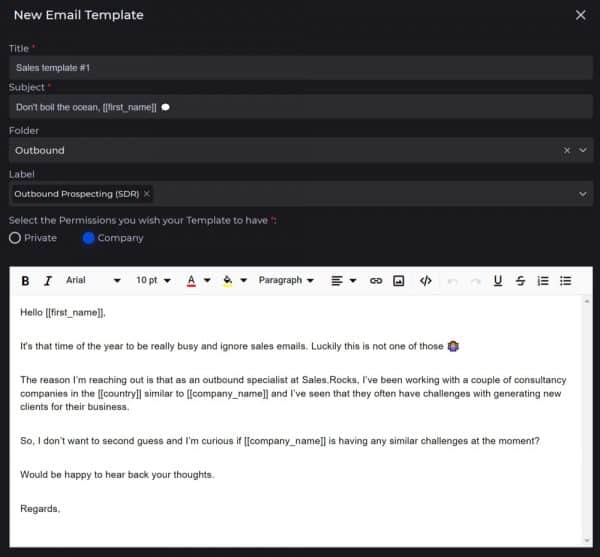
This email drip was used for reaching out to C-Level prospects in small and medium companies.
The wording of the subject lines copy was meant to reflect at. The meaning it conveys is don’t let your business get overtaken by multiple challenges. In other words, SMBs often face a multitude of challenges when experiencing a sudden outburst of growth. Mainly difficulties with managing sales growing sales teams and engaging increasing numbers of existing and potential customers.
The introduction uses a bit of humor, just enough to ease the mood before going for the pitch. The second part uses a relatable pain point that many other companies like their own may be facing. To close off the email, the CTA requires a clear yes or no answer on their part.
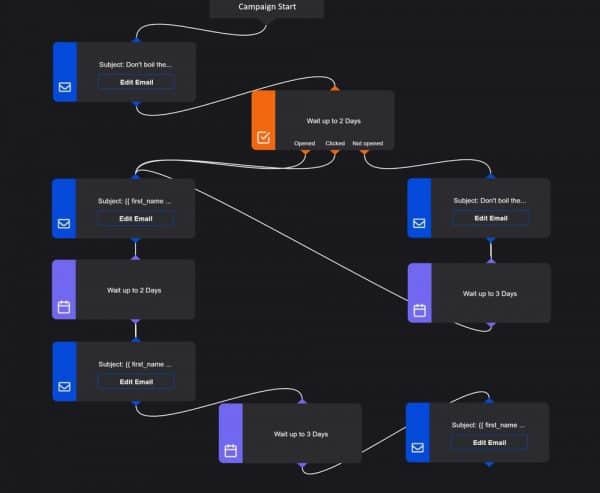
The drip campaign has all three outcomes the prospect can make covered, with a slightly more aggressive time schedule due to the nature of the high-profile target audience.
Sales outreach campaign #2
Email campaign stats:
Open rate: 73%
Reply rate: 32%
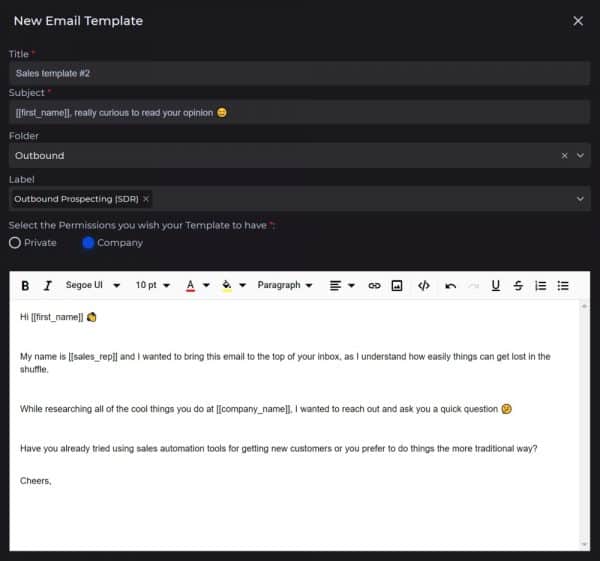
The subject line serves to provoke the recipient’s curiosity and going by the open rate, it is safe to say it succeed. But that only half the job is done.
The email copy focuses on qualifying the prospect, by discovering two things. Firstly if they are using a competitor’s product and to see whether they are in need of improving their sales process with the use of sales automation.
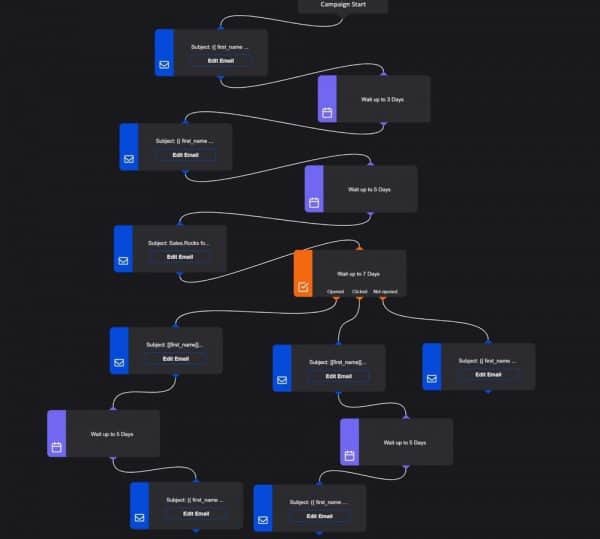
Because of the larger segment of target prospects, the drip sequence is more complex and lasts longer as well.
Sales outreach campaign #3
Email campaign stats:
Open rate: 52%
Reply rate: 15%
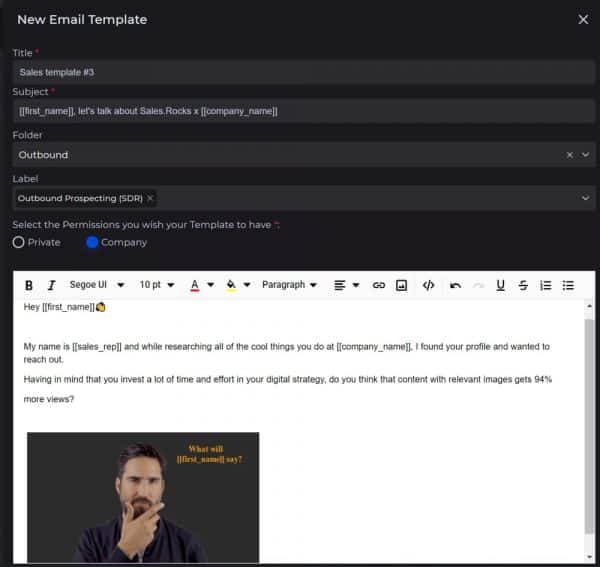
This is a pretty straightforward campaign with a twist. Using an emoji is a great way to add a bit of visual style to your email copy. Moreover, the second part of the email directly engages the prospect with the help of a personalized image.
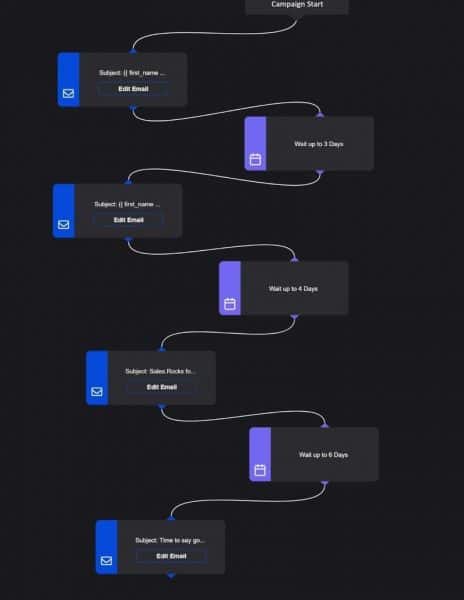
The email sequence is a standard template which as you can tell by the open and reply rates still works quite well. This s is because the main benefit of the sequence lies in its simple approach and image personalization.
It’s time to create your email drip campaign
You can use email drip campaigns for different purposes in your marketing and sales outreach. Lead nurturing, engaging prospects and outbound sales rely on continuous interaction with your potential customers. This is where drip campaigns shine with the help of accurate targeting, hyper-personalization and automation.
Follow out tips and tricks to make your emails engaging and your drip campaigns more effective. If you want you can use the email templates we’ve shared here or the ones in our email template library on the platform. Good luck with your email campaigns and we can’t wait to see your campaign metrics improve.
Learn how to drive more sales


